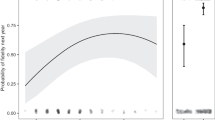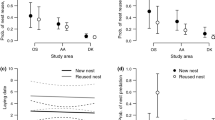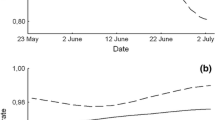Summary
We studied nest-site and mate fidelity in renesting Common Terns (Sterna hirundo), from 1993 to 1997, in a Common Tern colony breeding on six small artificial islands in the harbour area in Wilhelmshaven (German North Sea coast). Implanted transponders made possible individual recognition of the adults throughout their lifetime. We compared intra-season rates of nest-site and mate fidelity with between-year rates. Intra-season divorce was never observed. On the other hand, inter-year divorce was estimated at about 25%, suggesting that the costs of intra-season divorce are higher or opportunities for divorce are lower than between years. For 75% of 26 pairs that renested within the same season, the distance moved was less than 4.3 m. For 75% of 57 faithful pairs between two consecutive seasons, the distance moved was less than 1.25 m. Dispersal distances between and within years did not differ significantly but were clearly shorter than a paired random distribution of nests. Most of the birds changed the nest-site either when renesting or between years, but most of the new scapes can be considered as lying within the original territory. Thus, failure of the first breeding attempt increased neither divorce nor nest-site dispersal as compared with between-year rates. We also studied the influence of parental age and the date of breeding failure on distances moved in renesting birds. Late renesting pairs did not change the nest-site. A multiple regression analysis revealed that the longer the duration of the first breeding attempt and the older the pair, the shorter the nest dispersal distance.
Zusammenfassung
Von 1993–1997 untersuchten wir Neststandort- und Partnertreue ersatzbrütender Flußseeschwalben (Sterna hirundo) in einer Kolonie, die im Banter See, Wilhelmshaven, auf sechs künstlichen Inseln brütet. Transponder ermöglichten die lebenslange individuelle Erkennung der Altvögel. Neststandort- und Partnertreue innerhalb der Brutsaison und zwischen den Jahren wurden verglichen. Innerhalb der Brutsaison kam Scheidung nicht vor. Eine Trennungsrate von 25% zwischen den Jahren deutet darauf hin, daß die Kosten einer intrasaisonalen Scheidung höher sind als die diejenigen einer Scheidung zwischen den Jahren. 75% der ersatzbrütenden Paare wählten den neuen Neststandort weniger als 4,3 m vom Platz des Erstgeleges entfernt (n=26). 75% der partnertreuen Paare brüteten im Folgejahr nur 1,25 m entfernt vom Neststandort des Vorjahres (n=57). Die Entfernungen zum Neststandort des Folgegeleges innerhalb und zwischen den Jahren unterschieden sich nicht signifikant, waren aber deutlich geringer, als nach einer Zufallsverteilung zu erwarten war. Die meisten Flußseeschwalben wechselten den Neststandort bei einer Ersatzbrut oder im Folgejahr, aber meist wurde das folgende Gelege im ursprünglichen Territorium angelegt. Folglich führt ein Verlust der Erstbrut weder zu erhöhter Scheidungsrate noch zu stärkerer Verlagerung des Neststandorts, verglichen mit der Situation zwischen Jahren. Auch der Einfluß des Alters und Termins des Brutverlusts auf die Distanzen zwischen Erst- und Ersatzgelege wurden untersucht. Späte ersatzbrütende Paare verlegten ihren Neststandort nicht. Eine multiple Regressionsanalyse verdeutlichte, daß die Distanz zum Ersatz-Neststandort abnimmt, je länger der erste Brutversuch andauerte und je älter das Paar war.
Similar content being viewed by others
References
Aebischer, N.J., Potts, G.R. & Coulson, J.C. (1995): Site and mate fidelity of ShagsPhalacrocorax aristotelis at two British colonies. Ibis 137: 19–28.
Arnold, J.M., Nisbet, I.C.T. & Hatch, J.J. (1998): Are common terns really indeterminate layers? Responses to experimental egg removal. Colonial Waterbirds 21: 81–86.
Ashmole, N.P. (1963): The biology of the Wide-awake or Sooty TernSterna fuscata on Ascension Island. Ibis 103b: 297–364.
Austin, O.L. (1947): A study of the mating of the Common Tern (Sterna hirundo). Bird Banding 18: 116.
Austin, O.L. (1949): Site tenacity, a behaviour trait of the Common Tern (Sterna hirundo). Bird Banding 20: 1–39.
Austin, O.L. (1951): Group adherence in the Common Tern. Bird Banding 22:1–15.
Becker, P.H. (1995): Effects of coloniality on gull predation on Common Tern (Sterna hirundo). Colonial Waterbirds 18: 11–22.
Becker, P.H. (1998): Langzeittrends des Bruterfolgs der Flußseeschwalbe und seiner Einflußgrößen im Wattenmeer. Vogelwelt 119: 223–234.
Becker, P.H. & Anlauf, A. (1988): Nistplatzwahl und Bruterfolg der Flußseeschwalbe (Sterna hirundo) im Deichvorland. II. Hochwasser-Überflutung. Ökol. Vögel 10: 45–58.
Becker, P.H. & Finck, P. (1985): Witterung und Ernährungssituation als entscheidende Faktoren des Bruterfolgs der FlußseeschwalbeSterna hirundo. J. Ornithol. 126: 393–404.
Becker, P.H. & Wendeln, H. (1997): A new application for transponders in population ecology of the Common Tern. Condor 99: 534–538.
Black, J.M. (1996): Partnership in birds: the study of monogamy. Oxford: Oxford University Press.
Burger, J. & Gochfeld, M. (1991): The Common Tern. New York: Columbia University Press.
Cezilly, F. & Johnson, A.R. (1995): Re-mating between and within breeding seasons in the Greater FlamingoPhoenicopterus ruber roseus. Ibis 137: 543–546.
Choudhury, S. (1995): Divorce in birds: a review of the hypotheses. Anim. Behav. 50: 413–429.
Coulson, J.C. (1966): The influence of the pair-bond and age on the breeding biology of the Kittiwake GullRissa tridactyla. J. Anim. Ecol. 35:269–279.
Coulson, J.C. & Thomas, C. (1980): A study of the factors influencing the duration of the pair-bond in the Kittiwake GullRissa tridactyla. In: Acta XVII Congressus Internationalis Ornithologici II. (Ed. by R. Nöhring): 823–33. Berlin.
Coulson, J.C. & Thomas, C.S. (1983): Mate choice in the Kittiwake Gull. In: Bateson. P.P.G.: Mate choice: 361–76. Cambridge.
Cuthbert, F.J. (1985): Mate retention in Caspian Terns. Condor 87: 74–78.
Dhondt, A.A. & Adriaensen, F. (1994): Causes and effects of divorce in the blue titParus caeruleus. J. Anim. Ecol. 63: 979–987.
Ens, B.J., Choudhury, S. & Black, J.M. (1996): Mate fidelity and divorce in monogamous birds. In: Black, J.M.: Partnerships in birds: the study of monogamy: 344–401. Oxford.
Ens, B.J., Safriel, U.N. & Harris, M.P. (1993): Divorce in the long-lived and monogamous oystercatchers,Haematopus ostralegus: incompatibility or choosing the better option? Anim. Behav. 45: 1199–1217.
Fairweather, J.A. & Coulson, J.C. (1995): Mate retention in the kittiwake,Rissa tridactyla, and the significance of nest site tenacity. Anim. Behav. 50: 455–464.
Gochfeld, M. (1980): Mechanisms and adaptive value of reproductive synchrony in colonial seabirds. In: Burger, J., Olla, B.L. & Winn, H.E. (ed.): Marine Birds: 207–70. New York.
González-Solís, J., Becker, P.H. & Wendeln, H. (1998): Causes and benefits of nest-site fidelity in Common Tern. Biologia e Conservazione della Fauna 102: ### ###In press.
González-Solís, J., Becker, P.H. & Wendeln, H. (In press): Divorce and asynchronous arrival in common ternsSterna hirundo. Anim. Behav.
González-Solís, J., Wendeln, H. & Becker, P.H. (1999): Nest-site turnover in Common Terns: possible problems with renest studies. Ibis 141: 500–502.
Götmark, F. & Andersson, M. (1984): Colonial breeding reduces nest predation in the Common Gull (Larus canus). Anim. Behav. 32: 485–492.
Greenwood, P.J. (1980): Mating systems, philopatry and dispersal in birds and mammals. Anim. Behav. 28: 1140–1162.
Greig-Smith, P.W. (1982): Dispersal between nest-sites by StonechatsSaxicola torquata in relation to previous breeding success. Ornis. Scand. 13: 232–238.
Hepp, G.R. & Kennamer, R.A. (1992): Characteristics and consequences of nest-site fidelity in Wood Ducks. Auk 109: 812–818.
Johnston, V.H. & Ryder, J.P. (1987): Divorce in larids: a review. Colonial Waterbirds 10: 16–26.
Lifjeld, J.T. & Slagsvold, T. (1988): Mate fidelity of renesting pied flycatchersFicedula hypoleuca in relation to characteristics of the pair mates. Behav. Ecol. Sociobiol. 22: 117–123.
Macdonald, M.A. 1977. Adult mortality and fidelity to mate and nest-site in a group of marked fulmars. Bird Study 29: 165–168.
Martin, T.E. (1993): Nest predation and nest sites. Bioscience 43: 523–532.
Massey, B.W. & Fancher, J.M. (1989): Renesting by california Least Terns. J. Field. Ornithol. 60: 350–357.
McNicholl, M.K. (1975): Larid site tenacity and group adherence in relation to habitat. Auk 92: 98–104.
Mills, J.A., Yarrall, J.W. & Mills, D.A. (1996): Causes and consequences of mate fidelity in Red-billed gulls. In: Black, J.M.: Partnerships in birds: the study of monogamy: 286–304. Oxford.
Neubauer, W. (1997): Beziehungen zwischen Paarbindung, Alter und Bruterfolg bei der FlußseeschwalbeSterna hirundo. Ber. Vogelw. Hiddensee 14: 37–45.
Nisbet, I.C.T. & Welton, M.J. (1984): Seasonal variations in reproductive success of Common Terns: consequences of predation. Condor 86: 53–60.
Nisbet, I.C.T., Winchell, J.M. & Heise, A.E. (1984): Influence of age on the breeding biology of Common Tern. Colonial Waterbirds 7: 117–126.
Ollason, J.C. & Dunnet, G.M. (1978): Age, experience and other factors affecting the breeding success of the Fulmar,Fulmarus glacialis, in Orkney. J. Anim. Ecol. 47: 961–976.
Parsons, J. (1976): Factors determining the number and size of eggs laid by the Herring Gull. Condor 78: 481–492.
Potts, G.R., Coulson, J.C. & Deans, I.R. (1979): Population dynamics and breeding success of shags,Phalacrocorax aristotelis, on the Farne Islands, Northumberland. J. Anim. Ecol. 48: 465–484.
Pugesek, B.H. & Diem, K.L. (1983): A multivariate study of the relationship of parental age to reproductive success in California Gulls. Ecology 64: 829–839.
Ricklefs, R.E. (1969): An analysis of nesting mortality in birds. Smithsonian Contributions in Zoology 9: 1–48.
Rowley, I. (1983): Re-mating in birds. In: Bateson, P.P.G.: Mate choice: 331–60. Cambridge.
Shields, W.M. (1984): Factors affecting nest and site fidelity in Adirondack Barn Swallows (Hirundo rustica). Auk 101: 780–789.
Slagsvold, T. & Lifjeld, J.T. (1990): Influence of male and female quality on clutch size in tits (Parus spp.). Ecology 71: 1258–1266.
Storey, A.E. (1987): Adaptations for marsh nesting in common and Forster's terns. Can. J. Zool. 65: 1417–1420.
Sullivan, M.S. (1994): Mate choice as an information gathering process under time constraint: implication for behaviour and signal design. Anim. Behav. 47: 141–151.
Switzer, P.V. (1993): Site fidelity in predictible and unpredictable habitats. Evol. Ecol. 7: 533–555.
Sydeman, W.J., Penniman, J.F., Penniman, T.M., Pyle, P. & Ainley, D.G. (1991): Breeding performance in the western gull: effects of parental age, timing of breeding and year in relation to food availability. J. Anim. Ecol. 60: 135–149.
Wendeln, H. (1997): Body mass of female Common Terns (Sterna hirundo) during courtship: relationships to male quality, egg mass, diet, laying date and age. Colonial Waterbirds 20: 235–243.
Wooller, R.D. (1980): Repeat laying by KittiwakesRissa tridactyla. Ibis 122: 226–229.
Author information
Authors and Affiliations
Corresponding author
Rights and permissions
About this article
Cite this article
González-Solís, J., Wendeln, H. & Becker, P.H. Within and between season nest-site and mate fidelity in Common Terns(Sterna hirundo) . J Ornithol 140, 491–498 (1999). https://doi.org/10.1007/BF01650993
Accepted:
Published:
Issue Date:
DOI: https://doi.org/10.1007/BF01650993




